| |
|
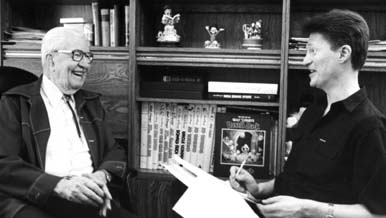 Getting My Ducks
in a Row
Getting My Ducks
in a Row
or: How I Write a Disney Comic
Carl Barks left behind
him a rich tradition of jokes and stories. His Donald Duck
and Uncle Scrooge comics boosted sales for Western Printing
in the 1940s and '50s, so much that the editors tried to ape
his storylines after Barks retired in 1966. When sales declined,
they fell back on reprinting his work. He is still the
model for Disney's prolific comic-book publishing machine in
Europe and has inspired such latter-day duck men as Don Rosa,
Daan Jippes, and myself. I've read his stories since childhood.
I can imitate the pacing, the cadences of speech; I've even polished
up a handful of his unfinished plots. Without Barks, there would
be no duck comics today.
At the same time, I can
imagine old Carl (he'd have been 102 this year) harrumphing at
some of the subjects I tackle. My own stories tend to reflect
my interests: 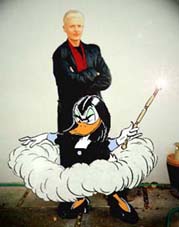 they're riffs on
a theme from fiction or music that's lodged under my skin, or
a crotchet I want to air. For instance, the soul-switching machine
in "Double Exposure" is based on an apparatus in that
short-lived TV series, The Secret Adventures of Jules Verne,
but I'd like to think my Röntgen camera is more than a gothic
plot device. It's a springboard for exploring the politics of
dressing edgy, our culture's fascination with the bad-boy image.
Picture the sorceress Magica de Spell inside Scrooge's body,
swanning around Duckburg in black leather and lecturing the city
fathers on getting in touch with their shadow side. Barks, who
could imagine potions that dehydrate ancient races and destabilize
modern faces, might still have balked at a gimmick that skirts
gender-bending. they're riffs on
a theme from fiction or music that's lodged under my skin, or
a crotchet I want to air. For instance, the soul-switching machine
in "Double Exposure" is based on an apparatus in that
short-lived TV series, The Secret Adventures of Jules Verne,
but I'd like to think my Röntgen camera is more than a gothic
plot device. It's a springboard for exploring the politics of
dressing edgy, our culture's fascination with the bad-boy image.
Picture the sorceress Magica de Spell inside Scrooge's body,
swanning around Duckburg in black leather and lecturing the city
fathers on getting in touch with their shadow side. Barks, who
could imagine potions that dehydrate ancient races and destabilize
modern faces, might still have balked at a gimmick that skirts
gender-bending.
Similarly, the life-size
projections in "A Holo Victory" owe their existence
to fantasies plucked from Star Trek, Buffy the Vampire
Slayer, and--would you believe?--Mozart's Magic Flute,
but the story itself is a projection of what happens when neighborly
squabbles reach the boiling point. I wrote it as a science-fiction
daydream, but that dream began in a rage against a bossy neighbor,
and some of the dialogue is lifted straight from life. Even so,
I balked when my editor suggested jacking up the holographic
violence in one scene. As Barks observed, you can't write horror
comics for Disney. He solved the problem many a time by writing
comedy; but his backyard farces about Donald and Neighbor Jones
can get mighty explosive. It's a thin line that divides our laughter
from our dark side.
For
that reason, Barks would have shunned this kind of introspection.
 He'd have preferred to show you
around his studio. Well, I don't have stacks of drawing paper
or a light board or ten different nibs to my pen, but I do have
writing down to a system. It's my living, after all. And while
I don't keep a file of National Geographics on hand for
inspiration, I have a hefty library of books and CDs and, when
that fails, access to the internet. I can let you into my workshop. He'd have preferred to show you
around his studio. Well, I don't have stacks of drawing paper
or a light board or ten different nibs to my pen, but I do have
writing down to a system. It's my living, after all. And while
I don't keep a file of National Geographics on hand for
inspiration, I have a hefty library of books and CDs and, when
that fails, access to the internet. I can let you into my workshop.
Every story begins as
notes: 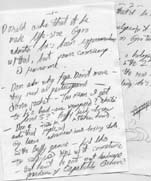 notes scribbled down
while reading or listening to music or--God help us--barreling
along the freeway. (Ideas must be snatched at the instant they
arrive.) When enough notes have accumulated, I gather up the
scraps of paper and type a synopsis. This forces me to weave
my ideas into a storyline. Much dialogue is drafted at this stage;
it helps builds connections between the key scenes, using characters'
gripes and wisecracks to carry the reader from, say, one crisis
at Scrooge's money bin to another at his warehouse. Just finding
and polishing the words I want helps knock off rough edges and
sometimes change the thrust of my initial inspiration. Often
I write too much dialogue and have to throw perfectly lovely
wisecracks into the wastebasket. notes scribbled down
while reading or listening to music or--God help us--barreling
along the freeway. (Ideas must be snatched at the instant they
arrive.) When enough notes have accumulated, I gather up the
scraps of paper and type a synopsis. This forces me to weave
my ideas into a storyline. Much dialogue is drafted at this stage;
it helps builds connections between the key scenes, using characters'
gripes and wisecracks to carry the reader from, say, one crisis
at Scrooge's money bin to another at his warehouse. Just finding
and polishing the words I want helps knock off rough edges and
sometimes change the thrust of my initial inspiration. Often
I write too much dialogue and have to throw perfectly lovely
wisecracks into the wastebasket.
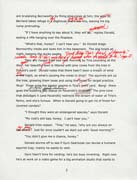 Once
the synopsis has been vetted (or shredded) by my editor, I revise
and tighten. New possibilities present themselves. The editor
insists that Huey, Dewey, and Louie cannot yearn to own a dog
because they already have a great big Saint Bernard. All right;
if I've got to mention Bornworthy, what gags can be created by
actually bringing him into the story? More ideas accumulate,
I research canine breeds or bird species or some recondite point
of black magic--my bank balance keeps dipping--until finally
I have to produce a story. Once
the synopsis has been vetted (or shredded) by my editor, I revise
and tighten. New possibilities present themselves. The editor
insists that Huey, Dewey, and Louie cannot yearn to own a dog
because they already have a great big Saint Bernard. All right;
if I've got to mention Bornworthy, what gags can be created by
actually bringing him into the story? More ideas accumulate,
I research canine breeds or bird species or some recondite point
of black magic--my bank balance keeps dipping--until finally
I have to produce a story.
For the first two years,
I would sit in my living room blocking out each script in longhand,
with chamber music pouring from the stereo. 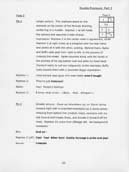 That
was fun, but it took too long, and transcribing the handwritten
pages took longer. Now I go directly to the computer and start
typing dialogue, using a previous script as template. Egmont,
the Danish publisher for whom I work, has a rigid scripting format--callouts,
punctuation, plain type for this and boldface for that--so it
helps to have a framework laid out. If I'm still not sure what's
going to happen when the ducks reach the Siberian pine forest
in Chapter Two, I trust to momentum. It's amazing what adrenaline
can accomplish, but first you have to build that adrenaline by
pounding out Chapter One. That
was fun, but it took too long, and transcribing the handwritten
pages took longer. Now I go directly to the computer and start
typing dialogue, using a previous script as template. Egmont,
the Danish publisher for whom I work, has a rigid scripting format--callouts,
punctuation, plain type for this and boldface for that--so it
helps to have a framework laid out. If I'm still not sure what's
going to happen when the ducks reach the Siberian pine forest
in Chapter Two, I trust to momentum. It's amazing what adrenaline
can accomplish, but first you have to build that adrenaline by
pounding out Chapter One.
When you're writing dialogue--when
I'm writing dialogue--the work goes quickly.  Dramatic
pronouncements and sassy retorts come easy to me, and I jot in
stage directions only to remind myself of crucial points in the
action. Dialogue for a twenty-four page script--that's roughly
200 frames--might take no more than ten days. Adding stage directions--then
thinning them so the editor doesn't blow a gasket--could burn
up two weeks more. I know exactly how each drawing has to look,
and I'm prepared to describe it--camera angle, scenery, props,
lighting, poses, motion lines--down to the crook of Daisy Duck's
little finger on a teacup. As part of Egmont's format, I also
provide miniature grids showing the panel divisions on every
page. That's how I learned to draw in Microsoft Word. Dramatic
pronouncements and sassy retorts come easy to me, and I jot in
stage directions only to remind myself of crucial points in the
action. Dialogue for a twenty-four page script--that's roughly
200 frames--might take no more than ten days. Adding stage directions--then
thinning them so the editor doesn't blow a gasket--could burn
up two weeks more. I know exactly how each drawing has to look,
and I'm prepared to describe it--camera angle, scenery, props,
lighting, poses, motion lines--down to the crook of Daisy Duck's
little finger on a teacup. As part of Egmont's format, I also
provide miniature grids showing the panel divisions on every
page. That's how I learned to draw in Microsoft Word.
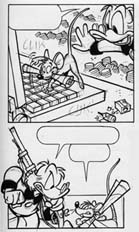 But
language is my medium, and I work it. Once the editor stopped
me dead in my tracks by saying, "You don't think I send
the artist what you actually wrote, do you? Leave him something
to do!" But
language is my medium, and I work it. Once the editor stopped
me dead in my tracks by saying, "You don't think I send
the artist what you actually wrote, do you? Leave him something
to do!" 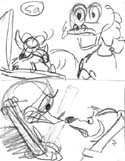 On the other hand,
he was thrilled with the paintings and photographs I sent to
model "Quest for the Golden Tusker"; he requested maps
and floor plans for two other stories; and I can tell from the
finished inks for "Powerplay on Killmotor Hill" that
artist Massimo Fecchi saw my pencil roughs. One picture's worth
a thousand words, it seems. On the other hand,
he was thrilled with the paintings and photographs I sent to
model "Quest for the Golden Tusker"; he requested maps
and floor plans for two other stories; and I can tell from the
finished inks for "Powerplay on Killmotor Hill" that
artist Massimo Fecchi saw my pencil roughs. One picture's worth
a thousand words, it seems.
When the script is done
and paid for, the editor will still want revisions, often months
down the line. Perhaps he's caught a glitch in the storytelling
or decided to tone down my satire. Now and then the artist gets
into the act: Daan Jippes objected that using a metal detector
to find Scrooge's dime in "Race for the Golden Apples"
was too obvious, and he was right. I had to unpick several scenes
in order to remove the device, but at least I got to do the unpicking.
Such rewrites can be time-consuming
but are generally easy. Six months after completion I'm less
invested in a story and more open to making changes. If I'm lucky,
I may get to critique the artist's pencils and even his inks.
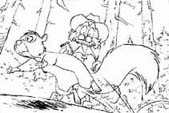 In the case of a pro like Jippes,
this is largely unnecessary. With up-and-coming talent, it's
more important, and I can only pray that the editor relays my
comments. Nothing's more annoying than to spend a day going over
someone else's work--worse, someone else's vision of your
work--and then to be told, "I didn't bother the artist with
all your nitpicks; at this stage we only want to catch major
errors." In the case of a pro like Jippes,
this is largely unnecessary. With up-and-coming talent, it's
more important, and I can only pray that the editor relays my
comments. Nothing's more annoying than to spend a day going over
someone else's work--worse, someone else's vision of your
work--and then to be told, "I didn't bother the artist with
all your nitpicks; at this stage we only want to catch major
errors."
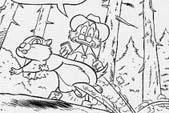 Now
the pages are off to production and out of my hands. One stage
remains, but for better or worse, it's a stage that doesn't involve
me. Each European publisher hires a translator to cast my script
into the local language. Most of them trample it with hobnail
boots, paring down, simplifying, and tossing out perfectly good
jokes. Only once did a Swedish translator contact me; he was
worried about some gags that wouldn't translate, but more worried
about the morality of my story "World Wide Witch."
Was it ethical to punish Magica de Spell for an internet crime
technically committed by Donald? What did that say about the
ducks' scruples? And why hadn't my editor told me that Don Rosa
had already established a first name for Scrooge's secretary? Now
the pages are off to production and out of my hands. One stage
remains, but for better or worse, it's a stage that doesn't involve
me. Each European publisher hires a translator to cast my script
into the local language. Most of them trample it with hobnail
boots, paring down, simplifying, and tossing out perfectly good
jokes. Only once did a Swedish translator contact me; he was
worried about some gags that wouldn't translate, but more worried
about the morality of my story "World Wide Witch."
Was it ethical to punish Magica de Spell for an internet crime
technically committed by Donald? What did that say about the
ducks' scruples? And why hadn't my editor told me that Don Rosa
had already established a first name for Scrooge's secretary?
I should have been grateful
for being consulted, but I could see a long, pointless e-correspondence
developing, so I bit him rather hard. No translator has contacted
me since. While perusing an Italian edition of the story, however,
I was pleased to see that translator Alberto Becattini had footnoted
one untranslatable gag, and his publisher had cared enough to
print that note in the margin. There's scruples for you.
So when a story finally
sees print--more than a year after I've written it, and in a
language not my own--it feels like the work of another man. In
truth, we're a collective: 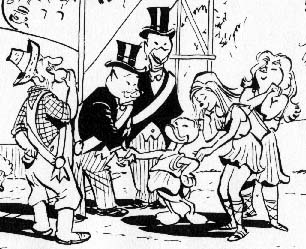 Barks,
channeled by me, via editor, artist, then translator--not to
mention the typesetters, programmers, and colorists. One of my
colleagues calls it a sausage factory. Sometimes I'm blown away
at how an artist has divined my intentions or made my story so
totally his own that quibbles don't matter. At other times I
want to tear out my hair. Barks,
channeled by me, via editor, artist, then translator--not to
mention the typesetters, programmers, and colorists. One of my
colleagues calls it a sausage factory. Sometimes I'm blown away
at how an artist has divined my intentions or made my story so
totally his own that quibbles don't matter. At other times I
want to tear out my hair.
That doesn't make me any
less proud.

Copyright ©
2003 by Geoffrey Blum
Disney character art copyright © 2003 by Disney Enteprises
|
|









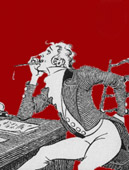
|
|

